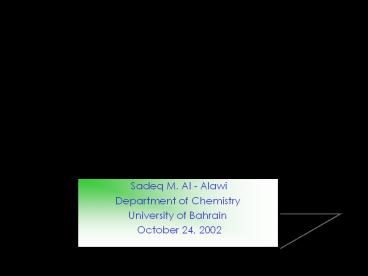Two-Dimensional Infrared Correlation in Time-resolved Spectroscopy - PowerPoint PPT Presentation
Two-Dimensional Infrared Correlation in Time-resolved Spectroscopy
... Infrared Correlation in. Time-resolved Spectroscopy. Sadeq M. Al - Alawi ... IR spectroscopy ... When a perturbation is applied to the system, various chemical ... – PowerPoint PPT presentation
Title: Two-Dimensional Infrared Correlation in Time-resolved Spectroscopy
1
Two-Dimensional Infrared Correlation in
Time-resolved Spectroscopy
- Sadeq M. Al - Alawi
- Department of Chemistry
- University of Bahrain
- October 24, 2002
2
Two-dimensional IR spectroscopy
- It is an analytical method based on time-resolved
detection of IR signals to study molecular
interaction
3
How does it work?
- When a perturbation is applied to the system,
various chemical constituents of the system are
excited. - The excitation and subsequent relaxation toward
the equilibrium can be probed with IR.
4
- The forward Fourier transform Y1(?) of the
dynamic spectral intensity y(?1,t)observed at a
wavenumber, ?1 is given by
5
Likewise, the conjugate of the Fourier
transform ?2(?) of dynamic spectral intensity
y(?2,t) observed at spectral variable ?2 is given
by
- ?2(?) y(?2,t) eit dt
- ?2re(?) -i ?2im(?)
6
The complex two-dimensional correlation intensity
is defined as
- ?(?1, ?2) i ?(?1, ?2) ?1(?) .
?2(?) d?
7
- Noda (1995) proved that the synchronous 2D
correlation spectrum can be computed without
Fourier transforming dynamic spectral data - ?(?1, ?2) y(?1,t) . y(?2,t) dt
8
Advantages
- Simplify complex spectra consisting of many
overlapped peaks. - Enhances spectral resolution by spreading peaks
over the second dimension. - Enables us to show the infrared bands that change
together in time.
9
(No Transcript)
10
(No Transcript)
11
(No Transcript)
12
(No Transcript)
13
(No Transcript)
14
(No Transcript)
15
Singular Value Decomposition SVD
- SVD method provides the mean to determine the
number of components involved in the
time-resolved spectra. - A U . W . Vt
- U defines the eigenvectors of the rows of A
- W represents the variance in the actual data
- V represents the spectral components
16
(No Transcript)
17
(No Transcript)
18
(No Transcript)
19
(No Transcript)
20
Thank U
PowerShow.com is a leading presentation sharing website. It has millions of presentations already uploaded and available with 1,000s more being uploaded by its users every day. Whatever your area of interest, here you’ll be able to find and view presentations you’ll love and possibly download. And, best of all, it is completely free and easy to use.
You might even have a presentation you’d like to share with others. If so, just upload it to PowerShow.com. We’ll convert it to an HTML5 slideshow that includes all the media types you’ve already added: audio, video, music, pictures, animations and transition effects. Then you can share it with your target audience as well as PowerShow.com’s millions of monthly visitors. And, again, it’s all free.
About the Developers
PowerShow.com is brought to you by CrystalGraphics, the award-winning developer and market-leading publisher of rich-media enhancement products for presentations. Our product offerings include millions of PowerPoint templates, diagrams, animated 3D characters and more.































